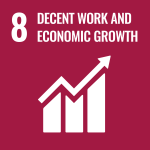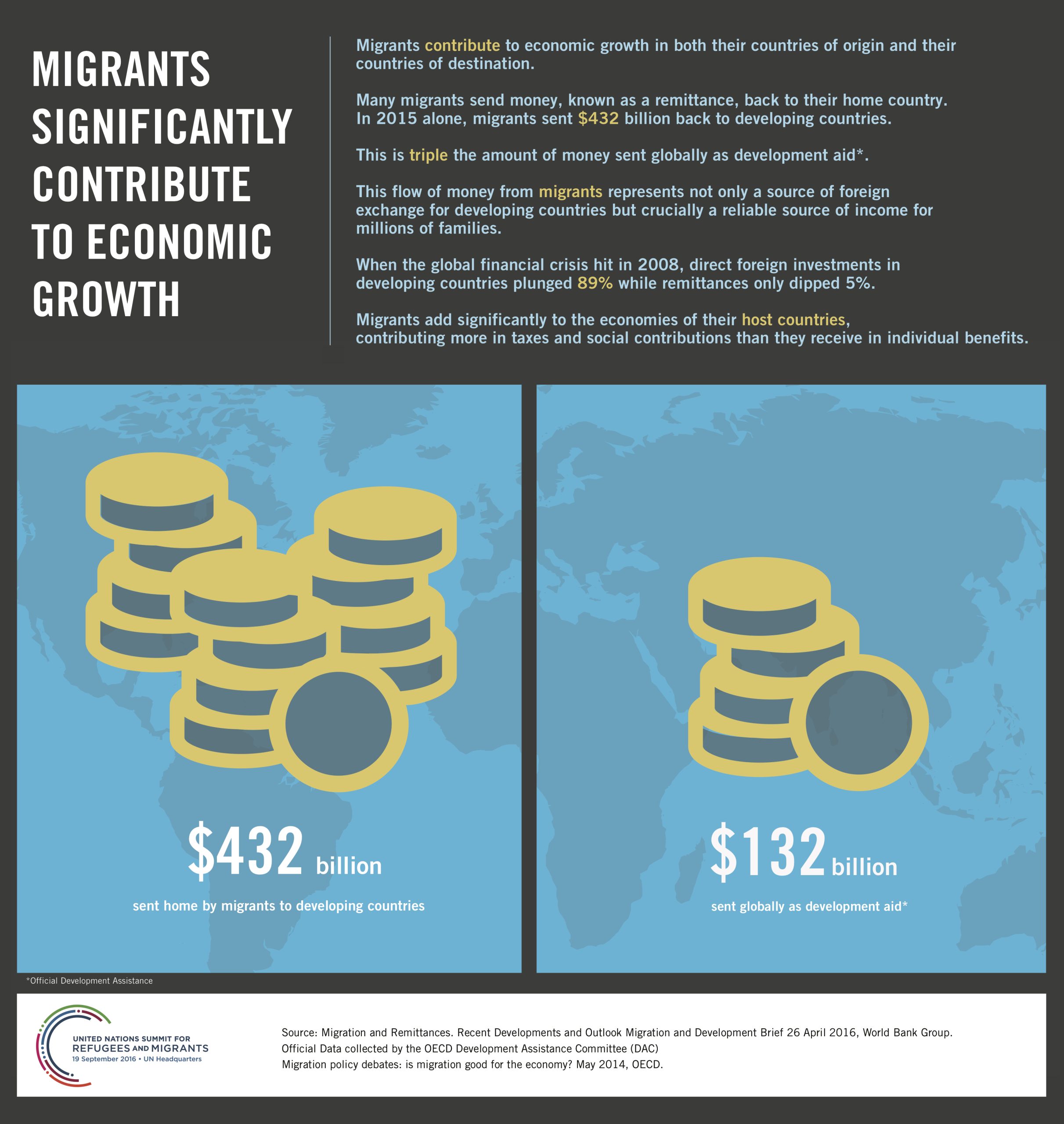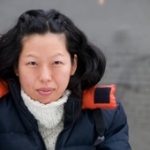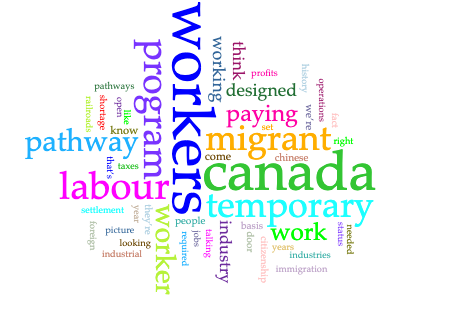Unit 9 City Life: SDG8
Decent Work and Economic Growth

Goal no. 8 of the 2030 Agenda for Sustainable Development aims to promote sustained, inclusive and sustainable economic growth, full and productive employment and decent work for all.
Click on the arrows to reveal more information about SDG8. You don’t need to remember everything you read – the main thing is to get an overview of this Goal.
Information and targets reproduced under the terms and conditions of United Nations websites. Copyright (2023). All rights reserved.
A reminder that links in this e-book do not open in a new tab. If you click on any link to a webpage, click the back button in your browser to return here.
Key vocabulary
Check that you know the meaning and the whole word family of these key words before you begin the Unit. (NOTE: there may be other versions of the word forms – these are the common forms in the context of SDG8). Also notice some common collocations in bold in the ‘Why this goal? and ‘Targets’ sections above. Add any new words, word families or collocations that you would like to remember to your vocabulary book.
Verb Noun Noun person Adjective
To economise economy economist economic/economical
To employ employment employer/employee employable/employed
To labour labour labourer laborious/labour-intensive
To emigrate emigration emigrant/émigré
To immigrate immigration immigrant
To migrate migration migrant
Introduction
In section 3 of Develop Your English you’ll learn about the struggle for dignity and decent living conditions that many individuals and communities face around the world. You’ll look at topics like forced labour and the lack of basic requirements such as clean water and decent housing.
In Unit 8 you found out about the lives of young refugees and the way that their life chances, including access to a decent education, are affected by their circumstances. In this unit you’ll find out about migrants – people who move from one place to another, especially in order to find work or better living conditions – and consider the way societies think about both refugees and migrants and the contributions they make to society.
Vocabulary – Easily confused words associated with people who leave their country
Drag and drop the correct definition below each of the 5 terms associated with people who leave their country.
In your local context…
- Do you have a migrant work population in your country? Or migrants who arrive to do temporary seasonal work? If yes, how are the migrants viewed and how are they treated by local communities and/or by the government?
- Do people regularly leave your local community to take up (temporary) work in other countries? If yes, what effect does this have on the local community?
Data Visualisation – Migrants significantly contribute to economic growth
Before you read
- Read the paragraph that introduces the topic of migrants and answer the question: Potentially, who benefits from migration?
The number of people migrating is increasing. People migrate for many reasons, including the need to look for work, to escape conflict zones, to escape inequality and because of the effects of climate change. Today over 258 million people are living outside their country of birth. Despite the challenges, migration can offer many opportunities and benefits not just to the migrants themselves, but also to their host countries and to their communities of origin.
- Scan the infographic (max 1 min) and find a word that means the money that migrants send home.
Read for detail
Read the infographic more carefully and complete the gaps in the summary with an appropriate word, phrase or statistic from the text. (Click here to see the infographic full screen).

Download the transcript here: Unit 9 Infographic transcript
Listening – How we treat migrant workers who put food on our tables (5.5 Mins)
![]()
Credit: The Conversation, Don’t Call Me Resilient 4. Ibrahim Daair, Culture + Society Editor and Vinita Srivastava, Host & Producer, Don’t Call Me Resilient | Senior Editor, Culture & Society. Licence: CC BY ND

Before you listen
Every year thousands of migrants go to work in Canada to harvest food, and are essential to the Canadian economy. In this podcast you’ll hear Professor Lee, who has been documenting the voices of migrant farm workers in Canada for two decades. She talks about their struggle to deal with harsh conditions, isolation, abuse, injury and even death as a result of immigration policies designed to leave them powerless and without any legal rights.
- Read the definition below that relates to migrant working conditions and think of some problems that might arise from this type of contract:
A work permit is an official document that gives a person permission to work in a particular foreign country. A tied (adj.) work permit is tied to a specific employer and only allows the person to work for the employer named on the permit.
2. Look at the word cloud created from the transcript. The most frequently used words (the biggest ones in the cloud) are: workers (16), Canada (14), labour (9), temporary (8), programme (8). With the title in mind (‘How we treat migrant workers who put food on our table’) create a sentence that uses as many of these words as possible and predicts the main point of the listening.

Listen for main ideas
Play the audio here
(Or access The Conversation podcast and listen from 13.48mins to 19.20mins).
Listen as Lee talks about the way that agriculture has been industrialised in Canada and how this impacts migrant workers. Listen just for main ideas until you hear her begin to talk about the fact that migrant workers have no pathway to citizenship, then listen for the detail that you need to complete the task below. Listen carefully and select the relevant details from the flow of information.
After you listen – Discuss
Discuss your personal response to what you have heard about the conditions for migrant workers in Canada.
Download the transcript here: Unit 9 Listening transcript
Reading – Refugees can actually create jobs for locals in growing cities – if given the chance
Before you read
Image attributions:
‘Azraq one year on: Syrian refugees in Jordan’ by EU/ECHO/Caroline Gluck /CC BY-NC-ND 2.0, flickr.com
https://upload.wikimedia.org/wikipedia/commons/1/16/KampalaRd_Uganda_house_Kampala.JPG CC BY-SA
Read for detail
In Unit 8 you read about Daahir, whose family left Somalia and became refugees in Kampala, Uganda. Read the ‘Making migration work’ section to find out more about Kampala and answer the 10 questions (use the blue arrow to access all of the questions).
Skim read
In the ‘Growing success’ section skim read just the first and last sentence of each paragraph. When you have finished, decide which of these two summaries best reflects the text:
- Refugees could contribute to the economic development of their host countries and benefit the local population, but governance issues have not been fully considered to allow this to happen, nor is there sufficient long-term planning to integrate the refugees.
- Large groups of people will continue to be displaced, and refugee camps will remain essential. Refugees should be discouraged from moving into cities as the challenges of integration are difficult to overcome.
Refugees can actually create jobs for locals in growing cities – if given the chance

The term ‘refugee’ conjures up certain images; bedraggled, desperate people hauling themselves onto lifeboats in the Mediterranean; or a vast sea of white tents – complete with blue UN logo – on the moon-like surface of some remote, arid land. But these scenes don’t capture how the vast majority of refugees actually live – not in branded tents, but in cities. Figures from the UN refugee agency (UNHCR) show that at the end of 2016, 60% of refugees lived in urban areas.
The fact is, more and more people will be living in cities in the coming years, while forced displacement is at its highest level in decades. Refugees are drawn to cities, where they can seek sanctuary from conflict, persecution or the effects of climate change in their places of origin.
Refugees are also spending longer away from home: at the end of 2016, 11.6m refugees had been displaced for at least five years – 4.1m of these for more than 20 years. Yet the social, political and governance issues which arise when urbanisation takes place alongside displacement have only recently begun to be considered in earnest – especially in Lebanon and Jordan.
In these places, thousands of Syrian refugees have moved into cities. Their arrival has changed the urban landscape considerably, put pressure on local services and stoked tensions between communities.
In sub-Saharan Africa, cities such as Kampala and Dar es Salaam also host thousands of refugees from the neighbouring countries of Burundi and the Democratic Republic of Congo. In Kenya, the Eastleigh district of Nairobi has long been a centre for Somali refugees, who have developed robust businesses and become part of the fabric of the city.
Making migration work
The unexpected influx of people – who may have different ethnic or religious backgrounds to the existing population – is often met with hostility by the locals, and viewed as a headache by city authorities. Displaced groups are seen as an added burden on already insufficient infrastructure and basic services, particularly in developing countries. The shock of displacement can also have a short term negative impact on GDP.
There is no denying it can be a big challenge to give displaced people access to basic services and employment. But refugees also bring with them a wealth of experience, opportunity and an entrepreneurial spirit, which can actually benefit their new neighbours. When refugees are given a chance to succeed, they can bring employment opportunities for the host population.
In Uganda for example, 21% of refugees own a business that employs more than one person – 40% of whom are Ugandan nationals. Displaced groups also become a new customer base for host communities, as has occurred in Greece, and old neighbourhoods can benefit from a new lease of life granted by the arrival of young families who can revitalise towns in decline, such as in Riace, in southern Italy.
Growing success
All developed economies have high levels of urbanisation, but with declining birth rates in these countries, other sources of labour will be required to keep the economy ticking over. Refugees could fulfil this purpose, spurring population growth and economic development. But so far, urban governance and planning structures have failed to capitalise fully on their potential.
The reality for cities and their residents is this: as long as instability reigns both in the political sphere and the natural world, large groups of people will continue to be displaced. Refugee camps have provided necessary sanctuary, but for people looking to rebuild their lives, they appear less and less inviting. The bright lights of the city hold the promise of opportunity for refugees; and with the right leadership, their success can benefit locals, too.
There are some obvious and practical steps which cities can take to help refugees become a positive part of urban life. Easy access to language classes, housing, education and the opportunity to work are key. In practise, city authorities must be more open minded about adopting creative solutions to housing shortages. They must reduce the bureaucracy, which often hampers efforts to get refugees into work: a wide variety of projects have been developed, from craft companies in Germany to a Swedish fast-track system. Technology can also be harnessed to provide educational resources and build much needed housing.
Integrating new arrivals to a city is never an easy task – even when successful, it takes time. But developing a long-term plan to help refugees settle into the city will make it much easier to confront the inevitable challenges that will occur. Germany is a good example of this, where authorities are trying to learn from the mistakes which have led to the segregation of populations in the past, such as in the banlieues of Paris. Such incremental and consistent improvements are neither exciting or divisive enough to garner much attention. But that does not make them any less valid. Refugees can indeed be of great benefit to cities and their residents – they just need to be given a chance.
NB This version of the article, with permission from the author, does not include the hyperlinks to supporting articles found in the original. Click the title for the full version of the text, published under a CC BY ND licence in The Conversation, which should be used for reference and sharing.
Vocabulary – Definitions: Business and the economy
In this activity you will check your knowledge about vocabulary associated with business and the economy. Click the ‘start’ button. Then click on one of the 7 coloured squares to zoom in. Think of a definition for the word or phrase in bold in the sentence on the square. When you have given the definition click the ‘flip’ button to turn the square over and check the answer. Click anywhere in the white area to move on the the next one.
Practice
Function – Paraphrasing
When you are in a conversation you might paraphrase what someone has said to show that you understand, or to check if you have understood it. In writing it’s a useful way of incorporating other people’s ideas into your own writing.
Focus on paraphrasing
Practice
Writing
In this Unit you’ve learned about the working conditions of migrant workers and refugees and their ability to access decent work and support economic growth. Nishantha’s story illustrates how investing in local industries can support local economies and at the same time support the environment. Nishantha lives in a rural area of Sri Lanka.
Read Nishantha’s story and write a response to it that incorporates what you know about the struggle for decent work experienced by many and SDG8 Decent Work and Economic Growth. Write about:
- The effects in this context of people leaving rural areas and moving to cities to look for work.
- Why people are reluctant to pass on the skills needed to farm Kithul trees to the next generation.
- The specific help Nishantha received that has improved his working life.
- Any other topic relevant to rural versus city life and SDG8.
Tapping into a Flood Resilient Future in Sri Lanka
“Many of these trees have been alive since my grandfather’s time, and I inherited several of them,” says Nishantha. Families like Nishantha’s have been farming Kithul tree (Fishatail Palm), which is native to rural Bulathsinhala, a village in the Kalutara district in the Western province of Sri Lanka. Although it can take up to 15 years for a Kithul tree to mature, it can produce sap for generations and be processed into jaggery, treacle and even flour.
However, the Kithul tree industry has been declining as the rural population migrates to the city. Most resist passing on the skills to the next generation because of the danger and risks.
With the help of the International Labour Organization (ILO), Nishantha received insurance policies that cover injuries and accidents. He now also has access to equipment to continue to tap Kithul trees with greater protection. “The hard hats and the safety belts we have received make our jobs safer, but also much more easy”, explains Nishantha. The ILO programme also brought together Kithul farmers across the country. They share their knowledge and expertise to ensure that the tradition will not be lost. For Nishantha, the art of growing a Kithul tree is a lifelong learning experience.
Nishantha treats his trees with the utmost respect for what they have provided him. He remarks, “The Kithul trees in my garden are what helped me and my family survive. I feel safe because my Kithul trees have been there for me.”
Department of Economic & Social Affairs Statistics Division (2022) ‘Bringing Data to Life: SDG impact stories from across the globe.’ Available at: https://unstats.un.org/sdgs/report/2022/SDG2022_Flipbook_final.pdf
Speaking
Read the summary and discuss the questions that follow.
SDG8 Summary
Preserving the environment is key to support sustainable economic growth as the natural environment plays an important role in supporting economic activities. It contributes directly, by providing resources and raw materials such as water, timber and minerals that are required as inputs for the production of goods and services; and indirectly, through services provided by ecosystems including carbon sequestration, water purification, managing flood risks, and nutrient cycling.
‘Natural’ disasters directly affect economic activities leading to very high economic losses throwing many households into poverty. Maintaining ecosystems and mitigating climate change can therefore have a great positive impact on countries` economic and employment sectors.
Sustained and inclusive economic growth is a prerequisite for sustainable development, which can contribute to improved livelihoods for people around the world. Economic growth can lead to new and better employment opportunities and provide greater economic security for all. Moreover, rapid growth, especially among the least developed and developing countries, can help them reduce the wage gap relative to developed countries, thereby diminishing glaring inequalities between the rich and poor.
Reproduced with kind permission of the UN Environment Programme. Copyright (2023). All rights reserved.
- All SDGs interact with one another – by design they are an integrated set of global priorities and objectives that are fundamentally interdependent. In this Unit you’ve learned about refugees and migrant workers and their struggle for decent work, as well as how they can contribute to the economic development of their host countries. In Unit 5 you found out about the rationale for better representation of women in the workforce and how it can help them be financially independent as well as contributing to the economy. Does the summary paragraph suggest any other overlaps between the goals in addition to this overlap between SDG8 Decent Work and Economic Growth and SDG 5 Gender Equality? Look at the 16 SDGs on the Welcome page to help you.
- Think about the relationship between SDG8 Decent Work & Economic Growth and SDG13 Climate Action. If enabling poorer countries to achieve higher levels of growth implies enhanced global consumption of carbon, how can we combat climate change? (McCloskey 2019).
- Can you give a definition for the words/phrases in bold above?
A reminder that if you have access to the internet and are studying by yourself without other people to practice your spoken English with, you can use artificial intelligence (AI) to gain fluency practice. See here for instructions and prompts.
Here are some prompts related to this Unit:
- ‘Tell me about refugee or migrant communities in [insert country] and let’s have a dialogue about their lives and working conditions.’
- ‘Let’s have a dialogue about the link between climate change and migration. Give me ideas to discuss with you, and correct any grammar mistakes that I make.’
Looking Ahead to Unit 10
In the next Unit you’ll be thinking about what makes cities and communities sustainable, including the creation of decent housing for the urban poor and ways to make buildings more resilient to climate change.
- How affordable is housing in your local context for average working people?
- Is city housing good quality accommodation?
- Are cities vulnerable to flood? Earthquakes? Other natural disasters?
Use the menu bar on the left hand side of the screen to access Unit 10

